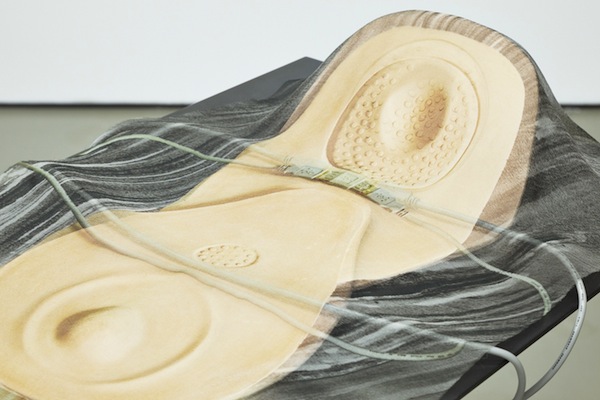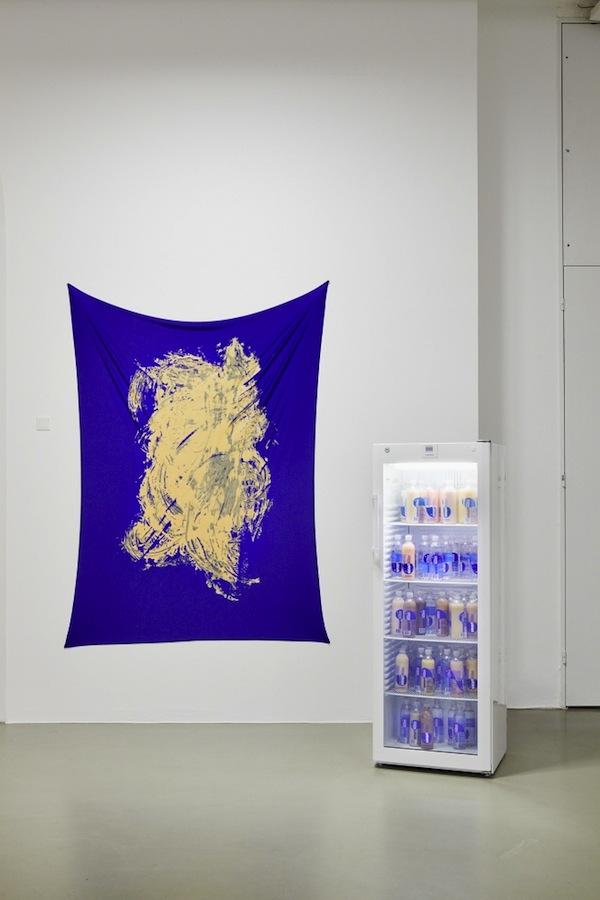Art World
Meet the Exciting Young Female Artists Rendering the Body in Grotesque Plastic
Alisa Baremboym, Olga Balema, and Pamela Rosenkranz lead the pack.

Alisa Baremboym, Olga Balema, and Pamela Rosenkranz lead the pack.

Alyssa Buffenstein

In sculpture and installation, artists are representing the body like never before. Flesh colors, biological media, and the slick, shiny textures of plastic grotesquely mimic human physicality. The material assemblages of these artists don’t figuratively represent the body, but allude to it in composition, color, and water content. Often working with themes of the technologically-mediated body, a squishy, squeamish, female-led trend has materialized, and it is as abject as it is attractive.
Two of the Paris-born, Berlin-based artist Juliette Bonneviot’s Xenoestrogen sculptures were featured in Future Gallery’s summer 2016 show, “Inflected Objects #2 Circulation – Otherwise, Unhinged.” The sculptures boast a list of media that includes lead, cadmium, aluminum, aspirin, oestradiol, soy, pesticide, and silicon rubber. Others from the color-coded series, which explores different materials that contain versions the human hormone estrogen, are made of flax and sesame seeds, copper, chromium, and Phthalates, a plasticizer found in floor lacquer.
Despite the stated chemical makeup of the works, their appearance is strikingly minimal. Flat wall objects hang like monochrome canvases in portrait orientation, all with a certain juicy shine. But by the time Peace Green and Sweet Star|Rouge Fatale had made it to Future Gallery, the silicon started to leak, and curator Melanie Bühler was given permission to shape them however she saw fit for the space, and they were bent and crumpled into organic shapes that better match their media.
Bonneviot’s work was also part of “When the Cat’s Away, Abstraction,” curated by Tina Sauerländer at Anna Jill Lüpertz Gallery in early 2016. The show explored abstraction between digital and physical realms, like Cecilia Salama’s poured latex objects meant to simulate Photoshop’s “liquefy” tool. For Salama, a digital tool inspires a means of creating tactile, organic objects.
Similarly, the work of New York sculptor Amy Brener is like a flexible second skin made of plant matter, e-waste, and other detritus encased in rubber molds. Pastel in color and iridescent in shine, Brener’s work was included MoMA PS1’s 2015 “Greater New York” show, and comprised one half of an exhibition at Berlin’s Wentrup Gallery this summer. These artists approach the digital/physical divide, and yield comparable tactile results.
Meanwhile, in May 2015, Croy Nielsen exhibited “Cannibals,” a solo show by Olga Balema. Threat to Civilization 1 – 6 is a series of soft PVC sacs filled with cloudy, putrid yellow water, and shaped vaguely like severed limbs. Slumped around of the gallery, the series was displayed with Border/Boundary 1 – 3, a trio of white curtains cutting into the room from different angles. Associations with IV fluids and shared hospital rooms are strong.
If Balema’s Cannibals had ingested the work of a different artist, they might have drunk something concocted by Pamela Rosenkranz. The Swiss artist is known for working with clear plastics and semi-opaque flesh-toned liquids, like her installation Our Product for the Swiss Pavilion at the 2015 Venice Biennale. A pool of pinkish, “Eurocentric” skin color was contrasted with a glowing green room painted in “biologically attractive” paint, accompanied by sonic and olfactory elements: the computer-generated sound of rushing water, and the smell of “fresh baby skin”. Using technology, Our Product exaggerates and abstracts human physicality, questioning what cannot be man made in a 3D printed world.
Perhaps this was all foreshadowed by the Fridericianum’s exhibition “Speculations on Anonymous Materials” in 2013. Besides a Rosenkranz-signature refrigerator full of SmartWater bottles containing shades of skin-pigmented fluid, the exhibition featured various sculptural works by Alisa Baremboym, also incorporating the putty tone reminiscent of a European complexion. Porous Solutions (2013), made of a laundry list of materials including gelled emollient, mylar, silk, and magnets, is an assemblage of slick, wet-look textures topped with an envelope of hanging artificial skin. Another work, 6-D, is a rendering of a peach-colored object, arranged with a “usb cable with gender changer.”
Elsewhere in “Speculations” were Josh Kline’s disembodied silicon hands holding flesh-tone electronic devices. But where Kline explicitly connects the smartphone to the body, Rosenkranz and Baremboym skip literal figuration, and allude to corporeality in color, texture, and inclusion of mundane consumer products.

Pamela Rosenkranz, Purity You Can Taste (Ultra Strong Contents) (2013), and Purity of Vapors (2012). Installation view of “Speculations on Anonymous Materials,” Fridericianum. Photo ©Achim Hatzius, courtesy of Pamela Rosenkranz and Karma International, Zurich.
Together, these artists mark a movement in art towards something fleshy and object-oriented—one that casts and encases the body in resin; and is as infused with biological essences as it is readymade objects. Bonneviot, Salama, Brener, Balema, Rosenkranz, and Baremboym are just a few examples of champions of this abstracted and affective view of the body, rendered in hormone-filled plastic. With an emphasis on composite materiality, they are imagining, like a latex bodysuit or a silicon iPhone case, new layers of digitally- and chemically-mediated skin.